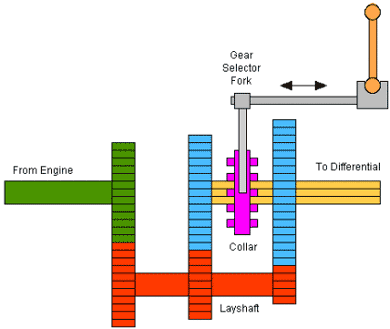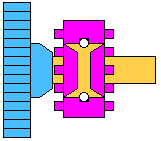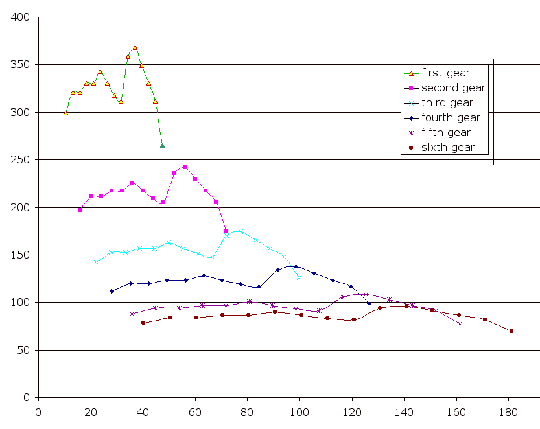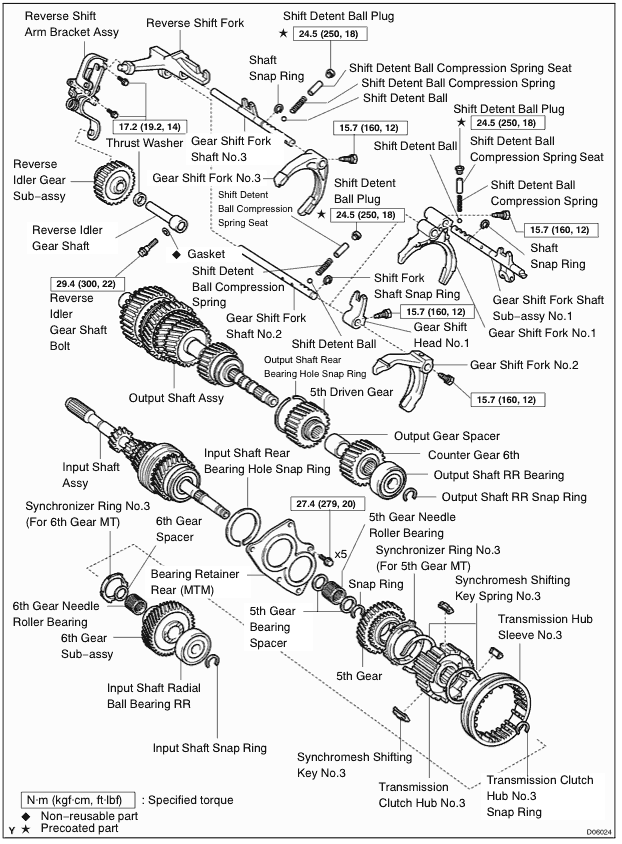How to Shift Your Elise
This is another in a series of articles that indicate how the Elise is different from other cars or how it can be enjoyed more fully. These are thoughts I have had while enjoying my car.
The shift linkage for the Elise is purpose built for the car and was designed by Matt Becker. The parts were not retained from the donor Toyota Celica.
This article assumes you know the basics on how to shift a manual transmission. The sequence of gear in neutral, clutch in, gear in first, clutch slowly out to get moving all provide a first time driver with happy memories. However a review of some of the mechanical process will help make shifting the Elise a bit easier to enjoy.

Shifting
The engine, through the clutch, is turning the green gear. The green gear can be disconnected from the engine when the clutch is depressed. The green gear turns the layshaft, which then turns all the blue gears. First and second gear are illustrated but the principle is the same for third - fourth and fifth - sixth. The yellow output shaft is connected to the rear wheels and is always turning if the car is moving. It is important to note the blue gears are rotating freely about the output shaft and are not connected to it. While the purple collar is in the middle, the gearbox is in neutral. Reving the engine will not cause the car to move.
Note how when the gear shift is pushed forward, the dogs on the collar engage the blue gear and connect it to the output shaft. Now the engine can drive the car forward.
Moving the gear back into neutral, where the collar and dogs are not connected to either gear, allows the first gear to again rotate freely.
Moving the gear lever further backward, connects the dogs to second gear. It is how these dogs connect the gear to the output shaft that is important. The dogs or bumps on the collar need to be aligned exactly before the collar can engage the gear completely. The collar slides along the grooves in the output shaft so the collar is always connected and turning with the output shaft.

Synchromesh
Synchromesh is a mechanism that facilitates the locking of the gear to the output shaft. The dogs are the bumps on the purple collar and fit into holes in the side of the blue gear.
When the driver is ready to shift into the next gear, the clutch is depressed. This disconnects the green input shaft from the engine and greatly reduces the rotating mass of the input shaft and layshaft. The rotation of the blue gears can now be easily sped up or slowed down, hopefully matching the speed of the output shaft. Should the clutch not be disengaged completely, the blue gears cannot be slowed or sped up.
The gear lever is moved towards the next gear. Note how the blue cone starts to spin against the yellow slide. Since the yellow output shaft is spinning and therefore the purple collar is also spinning, the friction of the blue cone will try and get the blue gear spinning at the same speed. This does not happen instantaneously but takes a moment, depending on the difference in the speed.
Once the speed matches, the dogs on the purple collar will slide into the blue gear and the gear will be connected to the output shaft. Now the driver can release the clutch and feed power to the engine, driving the car faster.

Determine Shift Points
The chart above graphs speed along the bottom axis and torque along the vertical axis. Each gear multiplies the torque of the engine, with the lower gear multiplying the torque more than the upper gears. First is shown in green and second in purple. The chart was derived by using the dyno data for a stock Elise and the stock gear ratios. Notice the line for first does not cross the line for second gear but third clearly crosses the line for fourth gear.
This chart shows when the most optimum time is to shift to achieve the best acceleration. Since the gears are well placed, in most cases you can shift just before the rev limiter comes on, especially the one-two and two-three shifts. Nick Adams suggested in the Lotus Forum that the rev limiter light comes on at the optimum shift point. In the case for the third to fourth shift, the graph suggests this might be at 7500 rpm, or where the lines cross.
Significant wear to the drive train can be limited by shifting earlier, even before the engine hits the high lift cam at around 6200 rpm. There is a SAE technical Series paper, Development of the High Speed 2ZZ-GE Engine, that discusses the increased wear and its management when the engine is on the high cam. So, when should you shift for normal, non-performance, driving?
I definitely shift before 6000 rpm to keep off the high lift cam and in fact usually shift before 3500 rpm. However I also believe the engine is a free reving engine and wear can be avoided at low revolutions by keeping above 2500 rpm when accelerating. For steady speed cruising, I try and keep the revolutions as low as possible, but above 1500 rpm. The engine is happy and I can always down shift if I need to accelerate. The engine revs at about 3500 rpm at normal freeway speeds. (This is not necessarily speeding as there is a 9% speedometer error.)
Pre-Load in the Gate
The preload springs in the shift gate push the gear lever towards the three-four part of the double H pattern. So moving the gear out of second with a gentle touch, will move the lever into the three-four gate. Similarly, moving out of the five-six gate with a gentle hand will allow the springs to move the lever into the three-four gate.
This preload helps move the shifter to where you want it or helps guide you outside of the three-four gate by forcing you to over come the preload. Moving between three and four requires no sideways effort and makes it easy to hit the target gear. Similarly moving from second to third requires a gentle hand to move the lever away from you and allowing the preload springs to force the lever across the gate from the one-two to the three-four. The same gentle hand is required to go from the five-six gate to the three-four when downshifting from fifth gear.
On the other hand, if you want to leave the three-four gate, you will have to consciously push against the preload spring to get out of this gate. Shifting from fourth to fifth requires a push to cross the gate and a similar effort to down shift from third to second. Even the shift from first to second requires you to maintain pressure to the left to keep the lever from returning to the three-four gate as you pass through neutral!
Some instructors suggest holding the shift knob in such a way as to promote the direction of travel. Palm towards you for a shift down the gate, palm at two o'clock when shifting from third to second and so on. This helps over come the preload at the neutral transition.
Actual Shifting
The shift mechanism is cable actuated and this results in some flexibility in the linkage. I had difficulty finding the right gears when I first drove the car. A shift to the wrong position would hit a block and no amount of wiggling would allow the engagement of the next gear. Later my psychokinesis allowed me to move to the correct spot easily. In the heat of competition or aggressive driving, I might still make the occasional mistake. Now I have no difficulties.
I am amused by those that have problems shifting and suggest that a short shift conversion will solve their problems! A short shift kit will only make the problem more difficult as with the shortening of the shift distance means the target spot for the shift is also smaller. Hitting a smaller target is just that much more difficult, especially if you are having problems hitting the larger target of the stock linkage!
It must be emphasized that the clutch needs to be fully disengaged! Do not shift out of a gear or into a gear unless the clutch is fully disengaged. This does not necessarily mean pushed to the floor. Each car has a different spot in the pedal travel where the clutch is opening fully. You can get a good idea about where this spot is by noticing the pedal position when getting the car rolling from a stop. This position is where the clutch is starting to engage. You must push the clutch past that point when shifting, but not very far past. Performance driving suggests you should not have any wasted movement and you should only disengage the clutch enough to get the job done. However the result of not pushing far enough will be damage to your gears and synchos! You will not allow the the dogs to mate with the gear, resulting in the grinding noise often heard with a missed shift or premature engagement of the clutch.
My first car was a Chevrolet Corvair, a great car in spite of what Nader says. The clutch is cable actuated. It broke once and I managed to limp home by shifting without a clutch. Carefully feathering the throttle allowed me to get out of a gear. Careful additional feathering of the throttle and matching speed with revolutions allowed me to find the next gear. It was difficult getting started from a stop as I needed to start the engine while first was engaged! This exercise teaches you exact rev matching but is very hard on the synchromesh.
Feeling the Synchromesh Working
As described earlier, synchromesh matches the output shaft speed with the gear speed. It requires pressure to make the shift cone press against the collar and friction to make the rotational speeds match. The greater the differences the harder you will have to push. This is why the down shift from second to first requires so much pressure.
One way to let the synchromesh work its magic is to not increase the pressure when shifting. A gentle touch will reduce the wear on this component.
I push gently into the next gear. I feel the resistance as the cone tries to spin down the gear, layshaft and input shaft. I do not increase the pressure rather I just maintain it. Amazingly, as soon as the speed matches, the gear engages without additional pressure. I just need to be patient and maintain the gentle pressure.
Rev Matching
You can avoid using the synchromesh when shifting altogether. Shifts will be faster, wear will be reduced, and you will gain the satisfaction of matching the gear and output shaft rotation.
There are several things you can do to match revs when shifting. For example, watch the revs carefully when making the shift from first to second, an up shift. Notice how the engine is turning slower when you get to the next gear. All you need to do is give the engine time to coast down before shifting to the next gear. When passing through neutral on your way to second, hesitate a moment and let the engine revs drop to exactly the point they will be once the clutch is released. These revs will be dependent on when you are shifting out of first and are affected by the speed the car is traveling. If you time it right, you will move the lever the rest of the way into second at the correct instant and let out the clutch. You can feel it if you did it correctly. Your passenger's head will not get thrown forward or backward. The engine tachometer will not go up or down at the instant you release the clutch. You will not feel the moment of hesitation in the gear lever that indicates the synchromesh is having to work. Practice. It feels great when it is done correctly.
You can accomplish the same Zen feeling when doing a down shift. However since the engine will be spinning faster in the new gear, you will have to speed it up some how. Double clutching allows you to speed up the gear train before engaging the next lower gear. Much is written as to if this is necessary given the modern technology found in the transmissions. Unfortunately you will do more harm than good if you attempt to double clutch and rev match on down shifts if you do it wrong. Another technique that can help is just blipping the throttle as you pass through neutral. This will not help the synchromesh but will keep you from unsettling the car when the clutch is finally released.
Double clutch is accomplished by disengaging the clutch, shifting into neutral, releasing the clutch and quickly blipping the throttle so the engine is tuning faster than it will eventually be once you have reached the next lower gear, disengaging the clutch, pushing the shift lever into the next lower gear, and releasing the clutch. These last two should happen right when the engine has coasted down to the speed it will be turning once it is connected to the rear wheels again. Again, you can tetll if you did it corectly by watching your passenger's head, your tachometer, and feeling how smoothly the gear lever makes the transition into the new gear.
As mentioned, rev matching is important on the track in order to avoid unsettling the car when the clutch is released. The contact patch of the tire is already stressed to the limit in the turn and any braking or acceleration will have to be also transmitted through the contact patch. By rev matching, no slowing or acceleration will happen and the contact patch can focus on cornering. The same goes for down shifting while braking. The contact patch is already stressed fully while braking, and adding additional braking force from the engine compression by shifting to a lower gear will cause the car to lose traction and potentially cause a slide.
I am sure others will have different thoughts about shifting. Comments are always welcome.

